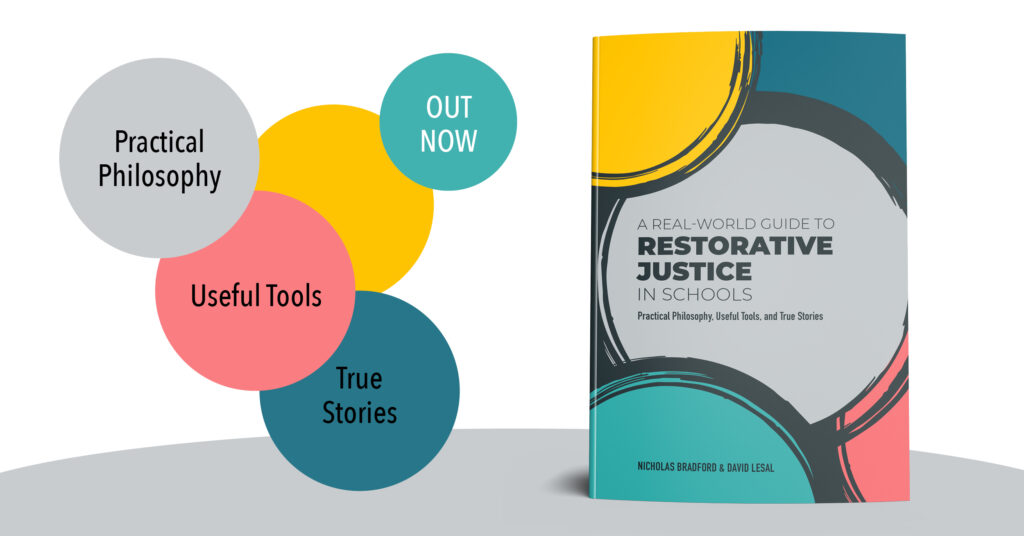A Real-World Guide to Restorative Justice in Schools releases on July 21, 2021.

Blog post by By David LeSal, education director of the National Center for Restorative Justice and Certified ELA teacher.
d.Lesal@nationalcenterforrestorativejustice.com
Twitter : @DavidLesal
n.bradford@ nationalcenterforrestorativejustice.com
Twitter : @RJFacilitator
When I first started using Restorative Practices, principles, and justice in my high school classrooms, I had a few great books on the theory of RJ and how implementation might work. However, I craved to know what it could really look like once I took the plunge and started facilitating circles and attempting harm-repair in my own space with students and community members. I knew it might not be as straight-forward as the books made it seem. Honestly, I would have loved a sneak peek into truly dynamic circles, where relationships were being deepened and where harm was being addressed openly and inclusively. I wanted to know what to do when things didn’t go as smoothly as planned. I wanted to feel like I was prepared for this challenging and exciting journey I was on as an educator. This is the book that I wish I had at that time.
Years later, I now feel far more confident in engaging students, staff, and families in this exciting work. This comes both from personal experience and learning from others. It has been an honor to help Nicholas (my co-author) facilitate outstanding Restorative Justice trainings to thousands of passionate educators in the Pacific Northwest and beyond through the National Center for Restorative Justice over the past few years. http://www.nationalcenterforrestorativejustice.com/
“In short, we designed this book to help you navigate the challenges and joys of building and maintaining a healthy restorative ecosystem in your school, while providing concrete tools and real-world stories to guide you through the process.”
I met Nicholas when he came to facilitate a PD session at the innovative public high school where I worked. Nicholas asked a striking question to our circle: “What led you into working in education?” As we passed around a talking piece and shared, I learned a great deal about my co-workers. In all honesty, I learned more about them that afternoon than I probably had in the two years I had been at the school. I learned, for instance, a co-teacher left a lucrative career as a stock trader to become a teacher after a call to action in a speech by Barack Obama. Nicholas chose a relevant and interesting question that pulled out a lot of vulnerability and depth from the group. How to ask great questions as a facilitator is one of the many exciting parts of the book we have written as a resource for others.
For anyone wishing that they had more time or opportunity to connect with RJ training or just to learn from other RJ practitioners, A Real-World Guide to Restorative Justice in Schools may well be for you!
It delivers a lot of the core concepts that Nicholas and I cover in our training courses, (such as: relationship building, cultural competency, shame vs accountability, resistant staff, and several powerful circle formats), a lot of the lessons I have learned while utilizing RJ as a high school teacher, advisor and Dean, as well as many inspiring true stories of RJ in action from educators and practitioners around the country.
In short, we designed A Real-World Guide to Restorative Justice in Schools to help you navigate the challenges and joys of building and maintaining a healthy restorative ecosystem in your school, while providing concrete tools and real-world stories to guide you through the process.
Traditional methods of discipline are commonly found to be ineffective. This book shows how restorative justice benefits schools in a huge variety of ways, such as decreasing the need for suspensions, increasing academic outcomes, and improving the health of your whole school community.
But RJ is a whole lot more than simply discipline reform, it is a mindset shift and a way of being in the world. A philosophy that treats everyone in the community, regardless of title, as equal and asks us to view harmful acts through the lens of relationships that will need to be repaired, not simply as acts that have broken rules and will demand punishments.
We hope you love it, but don’t take our word for it, here are some early reviews!
“The act of restorative practice is, by design, one of inclusion, and—to its immense credit— this book walks the walk, in ways that everyone can understand, by helping schools adopt new mindsets and restorative justice practices in their own communities.”
—Carlos Moreno, Executive Director, Big Picture Learning
“A solid text that transcends the usual approaches to this work. The authors’ use of real-world stories keeps this work trauma-informed, culturally responsive, and deeply personal. A text to return to over and over again.”
—Joe Brummer, consultant, trainer, and author of Building a Trauma-Informed Restorative School